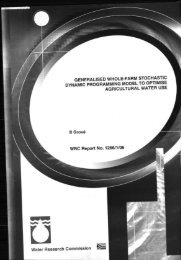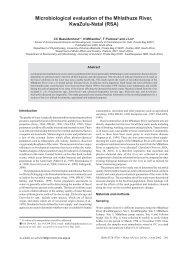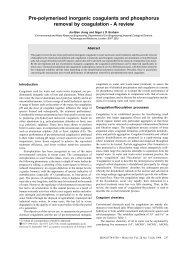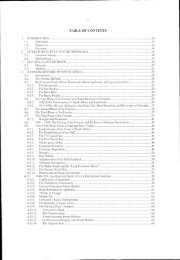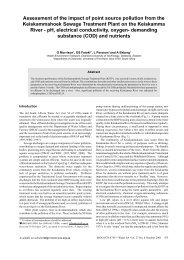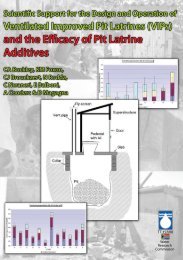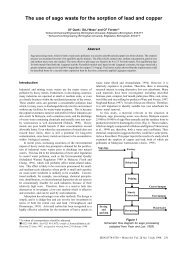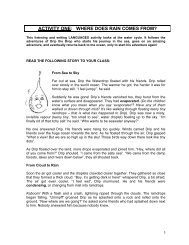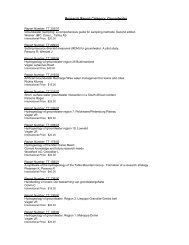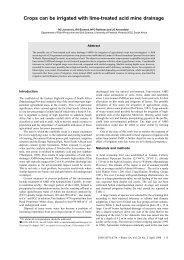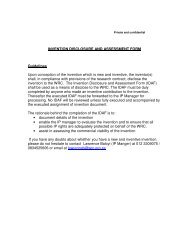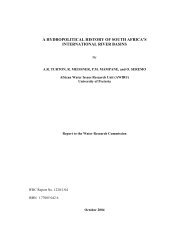A Methods Manual for the Collection, Preparation and Analysis of ...
A Methods Manual for the Collection, Preparation and Analysis of ...
A Methods Manual for the Collection, Preparation and Analysis of ...
Create successful ePaper yourself
Turn your PDF publications into a flip-book with our unique Google optimized e-Paper software.
photomicrographs earned high praise <strong>for</strong> <strong>the</strong> first six parts <strong>of</strong> this Flora. Un<strong>for</strong>tunately, <strong>the</strong>thorough treatment <strong>of</strong> each species was considered to be excessively costly <strong>and</strong> timeconsuming, resulting in <strong>the</strong> Flora being discontinued.After <strong>the</strong> curtailment <strong>of</strong> <strong>the</strong> Flora <strong>the</strong>re was a shift in <strong>the</strong> direction <strong>of</strong> diatom studies at <strong>the</strong>NIWR, <strong>and</strong> two lines <strong>of</strong> research were followed. The first <strong>of</strong> <strong>the</strong>se adopted a purelytaxonomic direction <strong>of</strong> study in which selected species were individually examined <strong>and</strong>thoroughly revised in <strong>the</strong> light <strong>of</strong> both type material <strong>and</strong> local material. Special attention wasfocussed on <strong>the</strong> genus Amphora, but o<strong>the</strong>r species in o<strong>the</strong>r genera were treated when <strong>and</strong> ifmaterial became available. The second line <strong>of</strong> research returned more to <strong>the</strong> style <strong>of</strong>investigation used by Cholnoky in his surveys from different regions but incorporated <strong>the</strong> newdevelopments in electron microscopy <strong>and</strong> photomicroscopy.At <strong>the</strong> end <strong>of</strong> 1986 Dr Schoeman left <strong>the</strong> NIWR, bringing to an end a fruitful partnership, inwhich he was <strong>the</strong> co-architect <strong>of</strong> so much that was achieved <strong>for</strong> over a decade. Continuing on<strong>the</strong> foundation laid by Cholnoky, <strong>the</strong> NIWR group had developed into <strong>the</strong> largest diatomresearch centre in <strong>the</strong> Sou<strong>the</strong>rn Hemisphere at that time. Details <strong>of</strong> this collection have beendiscussed in Harding et al. (2004).The third <strong>and</strong> fourth period <strong>of</strong> diatom research at <strong>the</strong> NIWR(CSIR) saw <strong>the</strong> strength <strong>of</strong> humanresources engaged in diatom work rise from one to four full-time researchers as well asseveral <strong>for</strong> whom diatoms were a secondary interest, <strong>the</strong>n decline again to one person, ArchieArchibald, occupied full time with <strong>the</strong> help <strong>of</strong> an assistant. Following <strong>the</strong> untimely death <strong>of</strong>Dr Archibald in December, 1999 meaningful diatom research ceased at <strong>the</strong> CSIR. The Diatomcollection was subsequently transferred to <strong>the</strong> CSIR in Durban under <strong>the</strong> care <strong>of</strong> ColinArchibald be<strong>for</strong>e his retirement in 2002.The fifth or current period <strong>of</strong> diatom research in South Africa includes research undertakenunder <strong>the</strong> leadership Pr<strong>of</strong> Guy Bate (University <strong>of</strong> Port Elizabeth now Nelson M<strong>and</strong>elaMetropolitan University) which commenced with a study <strong>of</strong> diatoms in South Africa in <strong>the</strong>late 1990’s. The research focussed on <strong>the</strong> ecological aspects <strong>of</strong> diatom assemblages <strong>for</strong>determining water quality <strong>and</strong> attempted to apply a descriptive European diatom index <strong>for</strong>South African conditions (Bate et al, 2002). This research continued with <strong>the</strong> publication <strong>of</strong> aWater Research Commission report relating freshwater, brackish <strong>and</strong> estuarine species to keywater quality variables (Bate et al., 2004).Also during this same period Dr Bill Harding commenced with an evaluation <strong>of</strong> <strong>the</strong> ex NIWR(now CSIR-Environmentek) diatom collection, as well as initiating fur<strong>the</strong>r diatom studies byproducing a set <strong>of</strong> protocols (<strong>of</strong> which this volume <strong>for</strong>ms a part) by which diatom samples canbe collected, prepared <strong>and</strong> <strong>the</strong> species in <strong>the</strong> samples identified – <strong>and</strong> by <strong>the</strong> use <strong>of</strong> whichdiatoms can <strong>for</strong>m a valuable component <strong>of</strong> biomonitoring in South Africa. Diatom studieshave also been undertaken in <strong>the</strong> last five years at <strong>the</strong> North-West University (Potchefstroom2



